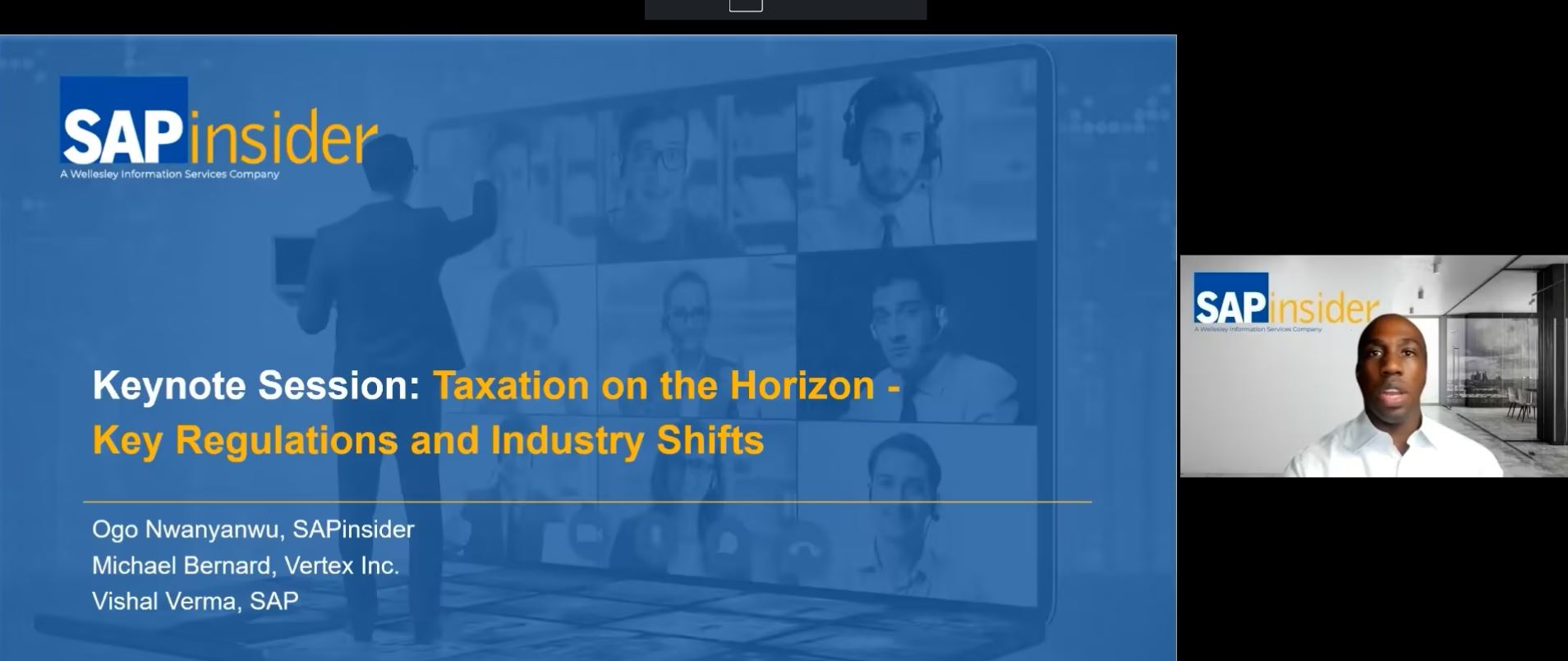Enhance Global Tax Management with Testing Automation
A Conversation with Suzy Soo at Vertex
Meet the Experts
Key Takeaways
⇨ Rapidly changing tax mandates require organizations to quickly deploy new indirect tax compliance functionality
⇨ Manual testing of tax-based processes within SAP ERP is inefficient creating need for automated testing applications
⇨ TestSuite offers testing automation of SAP transactions and documents enabling indirect tax compliance efficiency across core transaction flows, such as O2C and P2P
Indirect Tax Complexity Driving Constant Functionality Changes
Real-time reporting and e-invoicing mandates drive organizations to continually update and enhance global tax management functionality to accurately assess tax obligations promptly and avoid fines or other penalties. Growing complexity in compliance management, governance, and regulations is the primary driver of an organization’s digital tax strategy, according to data from our SAPinsider Trends in Tax Benchmark Report. Digital tax strategy is an organization’s approach to modernizing global tax management responsible for enabling continuous compliance of digital and traditional business activities. Validating new functionality across business activities with robust testing is critical to ensuring indirect tax determination, calculation, and reporting are accurate, thus enabling an effective digital tax strategy.
Yet, testing core business and tax-based processes with SAP data is a very labor-intensive task at a time when resources for robust manual testing after the initial implementation is often limited. As a result, organizations evaluate automated testing applications, such as TestSuite, to reduce the manual effort required to test SAP transactions and core business processes. Testing automation is a growing priority, whether you are transitioning to S/4HANA or optimizing core business processes, such as O2C and P2P, for more accurate indirect tax determination and calculation.
SAPinsider recently sat down with Suzy Soo, VP of SAP Business Development, at Vertex to better understand how testing automation tools, such as TestSuite, can help optimize core business and tax-based processes. TestSuite is part of Vertex Plus Tools offering for SAP ERP, providing organizations with standardized tools to enable SAP and Vertex integrations to support better tax accuracy.
Link to Video Technology Insight: Video Q&A and TestSuite Demo with Suzy Soo, VP of SAP Business Development at Vertex
Optimize Tax-based Processes with Testing Automation
Global organizations depend on SAP ERP to centralize data collection from transaction flows, touching multiple business units and source systems to enable effective global tax management. Currently, indirect tax mandates across various tax jurisdictions are based on rapidly changing business rules rather than uniform fixed tax laws, resulting in a more complex determination of tax obligations across transactions.
SAP ERP financial systems that manage transaction flows and integrate with global tax management solutions require frequent updates to comply with growing regulatory complexity. The breadth of updates can add to the workload of tax teams, leading to insufficient testing capacity. “There’s a lot of data and tax content that changes every month, so transaction flows must be re-tested repeatedly. Tax teams have to file returns and manage audits, and they don’t have the time to do the massive amount of testing needed every month to validate that rate and content changes are being applied correctly,” says Soo.
TestSuite allows organizations to mine and populate test scripts with pre-validated SAP data and documents. These capabilities enable tax managers to automate the execution of test transactions across order-to-cash and procure-to-pay processes, thus reducing the need for IT professionals. “That is one of the benefits of TestSuite is that you can re-execute the test cases with a push of a button and not only use it during your initial deployments but also use TestSuite during upgrades of applications,” according to Soo.
With testing automation, organizations can confirm comprehensive logging and integration with tax engines and sales & use tax applications connected to SAP. Customers can compare actual to expected taxability, tax code, and tax rate results, understanding the indirect tax liabilities they face. For organizations prioritizing efficiency across the indirect tax compliance lifecycle, tax teams can leverage automated testing tools to focus on more strategic activities.
Leverage Testing Automation During a Move to SAP S/4HANA
For our SAPinsider tax community, opportunities for tax automation aligned with a transition to SAP S/4HANA represent the second core driver of digital tax strategy, according to data from our Trends in Tax Benchmark report. SAP S/4HANA and the Universal Journal provide an efficient technical architecture for accurate transactional information and documentation recording. At the same time, in-memory computing empowers automation across core business processes, including the indirect tax compliance lifecycle. “With SAP S/4HANA, companies are looking for opportunities to leverage that migration to improve core business functions. Vertex has been automating indirect taxes for 30 years, but we still see many companies have several gaps around that (indirect tax compliance lifecycle) and want to find solutions that are global,” says Soo.
Recent data confirm the challenges organizations are facing to automate indirect tax functions. For example, research from our SAPinsider Automation in Finance Benchmark Report on finance process automation trends reveals tax automation as one of the most challenging processes for SAPinsiders to automate. Testing automation tools can help organizations validate indirect tax automation configurations of tax engines and sales & use tax applications connected to SAP. For example, TestSuite integrates with Vertex Indirect Tax Accelerator and Vertex Plus Tools to ensure proper deployment with SAP S/4HANA.
By optimizing business processes for accurate indirect tax calculation, organizations can realize more value from automation across the indirect tax compliance lifecycle. Soo echoes this sentiment, saying, “We can provide everything from the SAP side of things, all the Vertex products that support calculation, compliance, and analytics. Companies do not want to be stuck in the 1990s anymore, supplementing tax calculation with a lot of manual effort and a lot of struggles with the order-to-cash or procure-to-pay teams, and that is the direction that we are taking our clients into, and SAP S/4HANA is the perfect opportunity.”
Organizations can mitigate the risk of indirect tax compliance and tax automation deployment failures by leveraging testing automation tools during a transition to S/4HANA.
What does this mean for SAPinsiders?
Here are some key takeaways that SAPinsiders should keep in mind as they evaluate their technology needs for automated testing of core business and tax-based processes:
Confirm indirect tax compliance and content update requirements to support effective testing of tax-based processes. As organizations grow and expand into multiple regions, they create more cross-border transactions, adding complexity to the indirect tax compliance lifecycle. This challenge is shared across our tax community, as tax determination and indirect tax reporting represent the top pain points impacting the digital tax strategy of SAP organizations. In addition, compliance requirements can vary depending on the tax jurisdiction in which the organization and business units operate. So it is essential to ensure that tax automation solutions address core use-cases.
Consider opportunities to enhance audit capabilities across core businesses processes with automated testing of SAP documents. Finding data that effectively simulate historical transactions and business activity is a significant challenge for testing within SAP ERP systems. To ensure a robust testing automation tool is effective, it must be able to handle different data types, this includes financial data, master data, invoicing data, and product data. For example, TestSuite, allows for automated testing of SAP documents, enabling the optimization of core business processes, including order-to-cash and procure-to-pay flows.
Leverage automated testing to minimize compliance risk during migration to S/4HANA. Organizations are simplifying their SAP ERP landscape with a move to SAP S/4HANA and using the opportunity to implement more holistic tax-based automation solutions, such as a global tax engine. It is beneficial to partner with a third-party provider with a deep understanding of indirect tax complexities when evaluating a tax engine. The indirect tax complexity associated with a move to S/4HANA is significant, and testing automation can play a crucial role in supporting a successful migration of core tax functionality. In addition, automating the testing process can support the proper configuration of your SAP system and tax engine, ensuring effective indirect tax determination and calculation.








